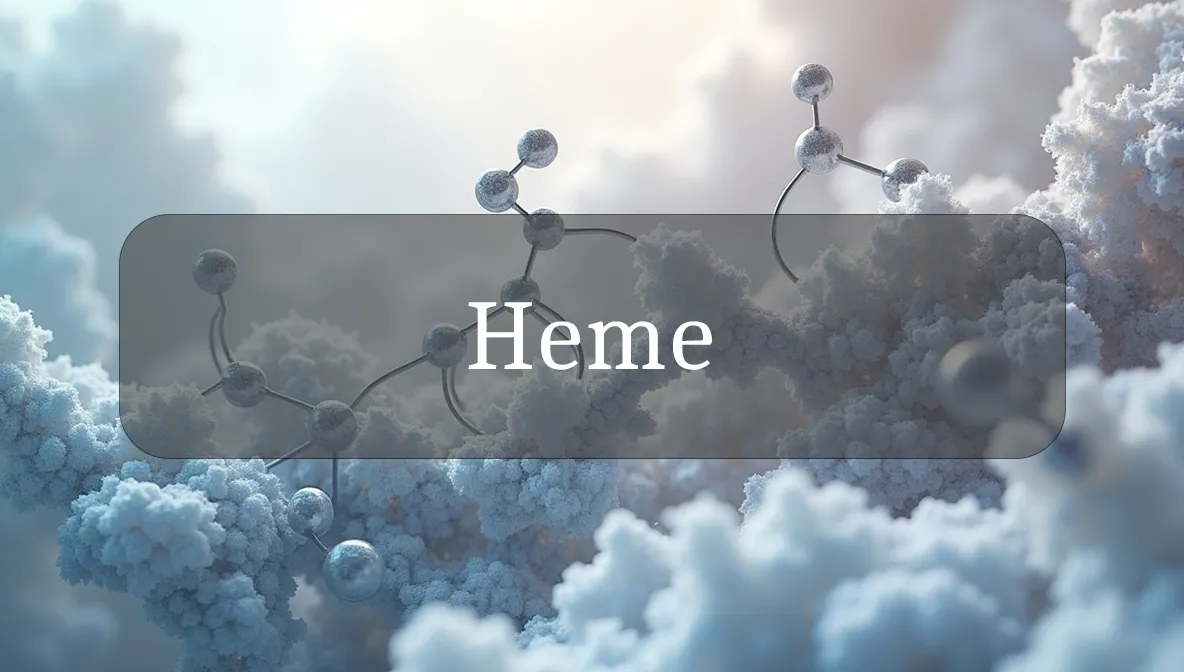Body’s Oxygen-Binding Powerhouse
Heme is an iron-containing molecule critical for oxygen transport, energy production, and detoxification in your body. As a key component of hemoglobin and other proteins, it supports vitality and health. Found in foods and synthesized internally, heme requires careful balance to avoid deficiency or excess. Let’s explore what heme is, its role in your wellness, and how to manage it for daily vitality.
Identity and Function
Heme is a porphyrin ring complex with a central iron ion (Fe²⁺ or Fe³⁺), forming a planar molecule (~616 Da). It’s a prosthetic group in proteins like hemoglobin (in red blood cells), myoglobin (in muscles), and cytochromes (in mitochondria and liver). Heme binds oxygen, facilitates electron transfer, or detoxifies compounds. Synthesized in the body via a multi-step process starting with glycine and succinyl-CoA, it’s tightly regulated to prevent toxicity from excess free heme.
Biological Role and Health Impact
Heme is essential for core physiological functions:
- Oxygen Transport: In hemoglobin, heme binds oxygen in the lungs and delivers it to tissues, supporting energy, stamina, and organ function. Myoglobin stores oxygen in muscles for exercise.
- Energy Production: Heme in cytochromes (e.g., cytochrome c) enables electron transfer in mitochondria, producing ATP via oxidative phosphorylation, fueling all cells.
- Detoxification: Heme in cytochrome P450 enzymes (liver) metabolizes drugs, toxins, and hormones, protecting against chemical stress.
- Antioxidant Defense: Heme proteins like catalase break down hydrogen peroxide, reducing oxidative damage and inflammation.
- Immune Support: Heme regulates immune cell function and inflammation, aiding infection resistance and tissue repair.
By enabling oxygen delivery, energy synthesis, and detoxification, heme keeps you energized, resilient, and healthy.
Production and Sources
Heme is both synthesized by the body and obtained from diet:
- Endogenous Synthesis: Produced in bone marrow (for red blood cells) and liver via the heme biosynthesis pathway, involving enzymes like ALA synthase. Requires glycine, succinyl-CoA, and iron.
- Dietary Sources: Found in heme iron from animal foods like red meat (beef, 2–3 mg/100g), liver (chicken liver, 9 mg/100g), poultry, and fish (salmon, 1 mg/100g). Heme iron is 15–35% absorbed, more bioavailable than non-heme iron (plants).
- Key Nutrients: Iron (meat, spinach), vitamin B6 (fish, bananas), and folate (leafy greens) support heme synthesis. Vitamin C (peppers, citrus) enhances dietary iron absorption.
- Regulation: Hepcidin controls iron availability, while heme oxygenase breaks down excess heme to prevent toxicity, releasing iron, carbon monoxide, and biliverdin.
A balanced diet with heme-rich foods and supporting nutrients optimizes heme levels.
Signs of Imbalance
Heme imbalances, often linked to iron or synthesis issues, can affect health:
- Heme Deficiency (Low Production):
- Symptoms: Fatigue, pale skin, shortness of breath, or weakness from anemia due to low hemoglobin (e.g., iron deficiency anemia). Cognitive issues or cold intolerance may occur.
- Causes: Low dietary iron, vitamin B6/folate deficiency, or genetic disorders like porphyrias impairing heme synthesis.
- Affects ~1.2 billion globally, especially women, children, or vegetarians. Hemoglobin <12 g/dL (women) or ferritin <30 µg/L indicates deficiency.
- Heme Excess (Rare):
- Symptoms: Abdominal pain, neurological issues (e.g., confusion), or liver damage from free heme accumulation, seen in hemolytic anemia or porphyrias.
- Causes: Excessive red blood cell breakdown (e.g., sickle cell disease), hemochromatosis, or rare synthesis disorders. Free heme can cause oxidative stress.
- Serum ferritin >300 µg/L (men) or unbound heme >50 µmol/L suggests overload.
- Toxicity (Very Rare):
- Severe hemolysis or transfusions may lead to kidney damage or organ failure from free heme toxicity.
If you notice fatigue, pallor, or neurological symptoms, see a doctor for tests like complete blood count, ferritin, or porphyrin levels.
Supporting Healthy Function
To optimize heme levels and maintain health:
- Eat Heme-Rich Foods: Include lean red meat, poultry, or fish 2–3 times weekly for heme iron. Pair with vitamin C-rich foods (oranges, tomatoes) to boost non-heme iron absorption from plants (lentils, spinach).
- Support Synthesis: Consume B6 (chicken, potatoes), folate (broccoli, beans), and iron-rich foods (liver, tofu). Avoid excessive tea/coffee with meals, as they inhibit iron absorption.
- Use Supplements Cautiously: Take iron supplements (18–65 mg elemental iron/day) only if deficient, as excess can disrupt heme regulation. Consult a doctor for dosing.
- Monitor Blood Loss: Address heavy periods, GI bleeding (e.g., ulcers), or frequent blood donations with medical care to prevent heme deficiency.
- Regular Checkups: Test iron status (ferritin, hemoglobin) every 1–2 years, especially if pregnant, vegetarian, or with family history of anemia or hemochromatosis.
Safety and Precautions
Heme is tightly regulated, but imbalances require care:
- Medical Conditions: Anemia, hemochromatosis, or porphyrias disrupt heme metabolism, needing tailored management. Thalassemia or sickle cell disease increases heme-related risks.
- Medications: Iron supplements may interact with antibiotics (e.g., tetracycline) or antacids, reducing absorption. Space dosing by 2 hours and consult your doctor.
- Excess Risk: Avoid high iron intake (>45 mg/day) unless prescribed, as it can cause oxidative stress or organ damage. Keep supplements away from children to prevent toxicity.
- Deficiency Risk: Pregnant women (27 mg/day iron need), infants, or vegetarians are prone to deficiency. Ensure fortified foods or supplements if needed.
- Porphyrias: Rare genetic disorders causing heme synthesis defects may lead to photosensitivity or neurological issues. Avoid triggers like alcohol or certain drugs.
If you have anemia symptoms, neurological issues, or concerns about iron intake, consult a healthcare provider for tests like hemoglobin, ferritin, or genetic screening.
Fun Fact
Did you know heme gives your blood its red color? The iron in heme reflects red light when bound to oxygen, making your veins glow with life while carrying oxygen to every cell!
Citations
- National Institutes of Health (NIH): Iron and Heme Metabolism.
- American Society of Hematology: Heme and Hemoglobin Function.
- Mayo Clinic: Iron Deficiency Anemia and Health.
- Journal of Biological Chemistry: Heme Biosynthesis and Regulation (2020).
- Blood: Heme in Health and Disease (2021).

